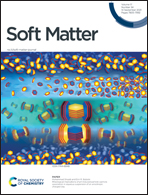Rheological implications of pH induced particle–particle association in aqueous suspension of an anisotropic charged clay†
Abstract
Kaolinite particles are geometrically anisometric and electrostatically anisotropic. Until recently, the charge of both basal faces of kaolinite was assumed to be independent of pH, and the isoelectric point (IEP) of the edge surface was thought to occur at pH 4–6. Therefore, kaolinite suspensions were expected to have an edge–face association at low pH. However, recent atomic force microscopy (AFM) studies have shown that the kaolinite alumina basal face and edge surface carry a pH-dependent surface charge with an IEP at pH 5–6 and ∼ 3, respectively. Here, we revisit the modes of particle association in kaolinite suspensions and apply Derjaguin–Landau–Verwey–Overbeek (DLVO) theory to study the rheological implications of surface charges of various kaolinite faces from recent AFM-based studies. Specifically, aging within the linear viscoelastic region, small amplitude oscillatory shear behavior (strain amplitude and frequency response), and critical stress behavior were studied as a function of pH. Kaolinite suspensions (40 wt%) exhibited two-step structure recovery after shear rejuvenation and two-step yielding at pH less than the IEP of the alumina basal face. In addition, the storage modulus (G′) and critical stress required to stabilize the flow followed non-monotonic behavior as a function of pH. At low pH, the silica face–alumina face mode of association was expected to be dominant rather than the edge–face microstructure. A peak in the G′ vs. pH curve at pH 4.5–5 was correlated with the silica face–alumina face attraction estimated from DLVO theory, which passes through a maximum at approximately the same pH. Based on these observations, we propose a qualitative state diagram for kaolinite suspensions in the pH-concentration space.



 Please wait while we load your content...
Please wait while we load your content...